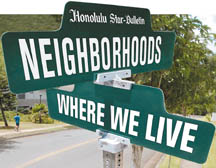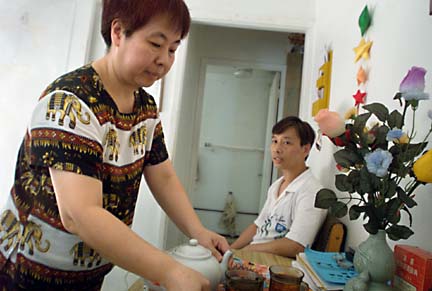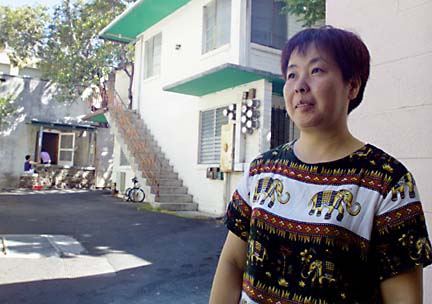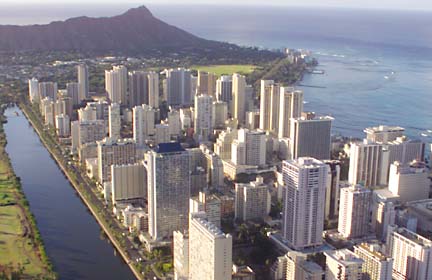
When the Chinese and Japanese immigrants arrived in the islands, they initially worked the plantation fields, but as more of their countrymen took up new lives in Hawaii, some established businesses to cater to them. Honolulu's Chinatown remains the landing point for legions of new immigrants, retaining a charming atmosphere despite rather seedy surroundings.
Amidst the financial district, Chinatown resounds in languages other than standard English and draws the more adventurous tourists and residents searching for good deals in the food stalls packed with fresh fish and produce and plain, no-fuss restaurants.
In sharp contrast stands Waikiki, an icon of Hawaii's tourism industry. Visitors seeking an island paradise of bygone years are sometimes shocked by the noise and bustle echoing through high-rise hotels and designer-label boutiques along Kalakaua Avenue.
Only glimpses of ocean appear between blocks of buildings, but the remnants of beautiful open shoreline still elicit gasps of wonder from faithful residents of an area once beloved by Hawaiian royalty.
Chinatown | Waikiki
BACK TO TOP |
GEORGE F. LEE / GLEE@STARBULLETIN.COM
Chinatown residents Mu Ju Yan and her husband, Gui Sheng Yan, serve tea to their guests in their home just off Maunakea Street.
Immigrant finds
hard work, better lifeA courtyard building is a new isle home
for recent arrivals from southern China
In the shadow of luxury high-rises, in a courtyard behind the lei shops, dim sum and pho restaurants on Maunakea Street in Chinatown is a community that the tourists and most locals rarely notice.
It's a neighborhood of immigrants, most from southern China, who have made Honolulu's Chinatown their first stop on the journey to a new life in the United States.
Walk through a gated alley next to a liquor store, and you'll find a complex of 18 apartments and a rooming house shaded by a large avocado tree.
It's where Mu Ju Yan, husband Gui Sheng, both 49, and their only daughter, Jie Ting, 21, live in a two-bedroom apartment. A map of the United States with cities and states written in Chinese characters is taped to a hallway wall.
"She wants to know more about the United States," said Yuk Pang Law, an immigration counselor who translated for Yan.
GEORGE F. LEE / GLEE@STARBULLETIN.COM
Mrs. Yan and her daughter, Jie Ting Yan, stand outside their apartment. The family moved to Hawaii last May and live in a courtyard building that is home to many other recent arrivals from southern China.
The Yans came to Hawaii last May from Guangzhou. She has two sisters who live in neighboring apartments with their families. Their father became a citizen several years ago, and that enabled his daughters to come to Hawaii.
"She feels if she works hard here, she can hold onto a job," Law translated.
Mrs. Yan poured tea for visitors in a tiny living room with furnishings from Goodwill and Savers thrift shops. Their daughter, however, has a brand-new computer in her room.
"In Guangzhou it's hard to save money to buy a computer. Here it is easy to save money to buy a computer," Mrs. Yan said.
The Yans pay $550 a month in rent plus utilities. Mrs. Yan works for a company that makes sushi and other snacks sold in convenience stores. Her husband makes sandwiches.
GEORGE F. LEE / GLEE@STARBULLETIN.COM
Chinatown resident Mu Ju Yan stands in the secluded courtyard of her apartment building.
When she first got here, Mrs. Yan worked a graveyard shift and walked home at 3 a.m.
"She feels it's kind of dangerous to come home and walk from Iwilei," Law said, so she took a daytime job at a garment factory until a day shift opened up at the food service company.
Occasionally, a drunk will wander into their courtyard complex and urinate on the wall, but Mrs. Yan said she still likes living in Chinatown.
"It's is very convenient, and everywhere she walks, they're all Chinese-speaking," Law translated. "Every day, she buys the Chinese newspapers."
The apartments in the courtyard are all rented by immigrants. Two apartments opened up recently because the families moved to better places in Liliha and Kukui Gardens. Relatives of a neighbor replaced them.
Mrs. Yan is studying English and hopes to become a citizen. She may eventually move out of Chinatown but wants to stay in Hawaii because her father is here and because the weather is good -- much better than in Guangzhou, where it can be hot and humid in the summer and freezing in the winter.
"Here it is always spring," she said.
BACK TO TOP |
RICHARD WALKER / RWALKER@STARBULLETIN.COM
An aerial view shows densely populated Waikiki, which is home to 20,000 full-time residents plus as many as 50,000 tourists some days.
Lively tourist spot
attracts residents, tooVolunteers patrol to spot petty
crime and dangling palm fronds
If Oahu is Hawaii's gathering place, then Waikiki is its condensed version. It has 20,000 full-time residents and as many as 50,000 visitors some days, spread over the former wetland's 50 streets and 2.5-mile, 500-acre "peninsula" bounded by Ala Wai and Kapahulu and Kalakaua avenues.
Waikiki straddles and battles a tightrope between being a place for residents and a destination for tourists, all the while being the most densely populated and transient area in Hawaii.
So why do people want to live in Waikiki?
"Are you kidding?" asked Alan Berkshire, of Manitoba, Canada, who has lived just off Kuhio Avenue for the last several months. "It's incredibly convenient, and there's more to do here than anywhere else on Oahu.
"Right outside my front door, I can catch a bus to anywhere on the island or walk five minutes to the beach. It's all here."
The first Waikiki settlers came from Polynesia in about 600 A.D. when the area was wetlands, covered by lush vegetation and replenished by several freshwater streams rich in fish and shellfish. It was perfect for growing bananas, coconuts, taro and other crops, which meant Hawaiians no longer struggled for survival.
In the 1920s the Waikiki reclamation programs began with the construction of the Ala Wai Canal transforming a community of taro and rice farmers and duck ponds into one of land developers and tourism entrepreneurs. Waikiki's wetlands were deemed unsanitary and dangerous by government officials because of unproved mosquito threats. The wetlands were dredged to build the Ala Wai Canal, then the Waikiki area was filled with the coral spoils. It wasn't long before low-rise hotels appeared to nourish a new crop: tourism.
Waikiki's beachfront has been the beneficiary of numerous and expensive improvements over the years: the new Kapiolani Park Bandstand, rebuilt police substation, new light poles on Kalakaua Avenue, renovated sidewalks along sections of Kapiolani Park, Kuhio Beach, Ala Wai Canal and Kalakaua Avenue. Meanwhile, residential Waikiki has been neglected so that much of its infrastructure -- street lighting and sidewalks -- is decaying. The city has proposed improvements to residential Waikiki, including the area's second-busiest thoroughfare, Kuhio Avenue.
The Waikiki of tomorrow may include pedestrian-only areas that extend from the ocean to the Ala Wai Canal, where there would be small cafes and shops, a new public park and parking spaces.
To help deter crime, local businesses and residents have created the Aloha Patrol, Hawaii's friendly version of Neighborhood Watch, normally done in groups of at least a half-dozen volunteers. They're identified by their Aloha Patrol T-shirts, dark blue with bright yellow letters front and back. The "O" in Aloha features a yellow hibiscus.
The volunteers look out for any untoward activities such as vice peddlers or people overcome by too many mai tais and infrastructure deficiencies such as cracks in the sidewalk, burned-out street lights or dangling palm fronds. They also help tourists who need directions or suggestions on restaurants, the best place to see the sunset or even how to catch Don Ho's show.
Members must not get involved in confrontations or make a citizen's arrest, so they carry cell phones for emergencies.
"The Aloha Patrol is the eyes and ears of Waikiki," says Kit Sakurai, manager for Crazy Shirts' Waikiki stores.
The Aloha Patrol was created in 1997 by a Waikiki hotel executive concerned that one of the world's most famous resort areas may become overrun with sidewalk vendors, hawkers, panhandlers, street performers and petty criminals.
It is a volunteer organization overseen by the Waikiki Ohana Workforce, an employee group. A half-dozen businesses select one evening a month for their group to walk along Kalakaua and Kuhio avenues and side streets.
"There are so many meanings to aloha that we wanted to be the living example, a reality," says patroller Bonnie Allen, 38.







